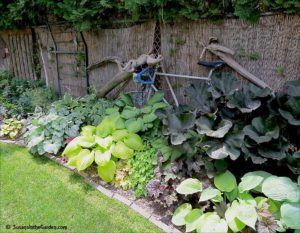July 26 column: Heucheras

If it’s Sunday, it must be time for another of my garden columns. This week’s is on two awesome perennials, heucheras and heucherellas. Here’s a link to the column in today’s edition of The Spokesman-Review: Heucheras add color in shady places. Or you can read my column below.
Many folks know heucheras by their more common name of coral bells. Heucherellas are a cross between a heuchera and a tiarella, otherwise known as foamflower.
Of course, there are now so many amazing cultivars out there, all prized for their amazing foliage. They add so much to the shady spots in our gardens.
Both heucheras and heucherellas have flowers but they tend to be rather insignificant. But boy, are the foliage colors amazing!
Both of these photos came from Master Gardener Martha Kenney’s lovely garden. Enjoy.
Column:
by Susan Mulvihill
When designing ornamental garden beds, we often tend to think in terms of colorful flowers. We don’t necessarily have to rely on flowers alone to add pizzazz to our landscapes. Two great alternatives are Heucheras and Heucherellas, both prized for their amazing foliage.
Heucheras, commonly known as coral bells, come in a wide range of colors. Heucherellas are a cross between a Heuchera and Tiarella, which many gardeners know as foamflower.
Martha Kenney is absolutely smitten with both of these plants. A Master Gardener since 2002, her main focus is on perennial gardening.
“I’ve had an interest in Heucheras for 37 years,” she explained. “There were lots of them growing at the house we were renting so our landlady let me bring them to this house.”
After that, a neighbor gave Kenney a Palace Purple hybrid. This cultivar was the beginning of a wave of heuchera hybridization in the plant industry.
“I thought Palace Purple was so cool,” she admitted. “Amber Waves was the next one that caught my attention, and that was it: I was hooked.”
Soon, Kenney and a fellow Master Gardener had a friendly competition going as they tried to keep up with the newest varieties introduced each year.
There are nearly 50 species native to North America. As members of the Saxifrage family, they are also referred to as alum root for their medicinal properties. Historians have noted that Heucheras can be seen in botanical prints going back to the 1600s.
For years, the common coral bells (H. sanguinea) were the only ones available in nurseries.
“The flowers were either red or pink, they had green leaves, and weren’t all that interesting except for some veining in the leaves,” Kenney said. “But they were not like the new cultivars.”
She feels Heucheras and Heucherellas have a lot going for them:
“The variety and leaf color is just unbelievable. They go from oranges and peaches, to deep purple to black, to everything in between. The flowers attract bees and hummingbirds, too.”
Both are shade plants that blend well with other shade-lovers such as hostas, brunneras, ligularias, ferns and cimicifugas. Having evergreen foliage, most Heucheras and Heucherellas, are very hardy and are deer-resistant. Some are even drought-tolerant.
“These plants need shade although some are more tolerant of sun than others,” Kenney said. “Water them regularly. Deadhead the spent flowers and cut off the old leaves in the spring. Otherwise, they really don’t need much care.”
While they are tough plants, she’s found that root weevils will occasionally nibble on the margins of the leaves but hasn’t come up with a successful method to combat them.
“I just figure they’re not killing the plant,” Kenney said. “Usually they are the worst in the fall when the plants are getting ready to go dormant anyway. If they were killing the plants, that would be a different story!”
Some of her favorite Heuchera cultivars include Southern Comfort with its huge copper leaves, splashy Mardi Gras, Sweet Tea, Mystic Angel, Peach Flambe (“it just glows when the sun shines behind the leaves”), Amber Waves, Lime Rickey and Midnight Rose. Two of her most prized Heucherellas are Brass Lanterns and Running Tapestry.
“Heucheras and Heucherellas have such variety in size, shape, color and go well with a lot of other shade plants,” she said. “I honestly think they should be a staple in every shade garden.”
If you’d like to see an online gallery of the amazing variety of colors that Heucheras come in, visit heucheras.com. I’m sure you’ll want some for your garden.Susan Mulvihill is co-author, with Pat Munts, of “Northwest Gardener’s Handbook.” Contact her at Susan@susansinthegarden.com and follow her on Facebook at facebook.com/susansinthegarden.

